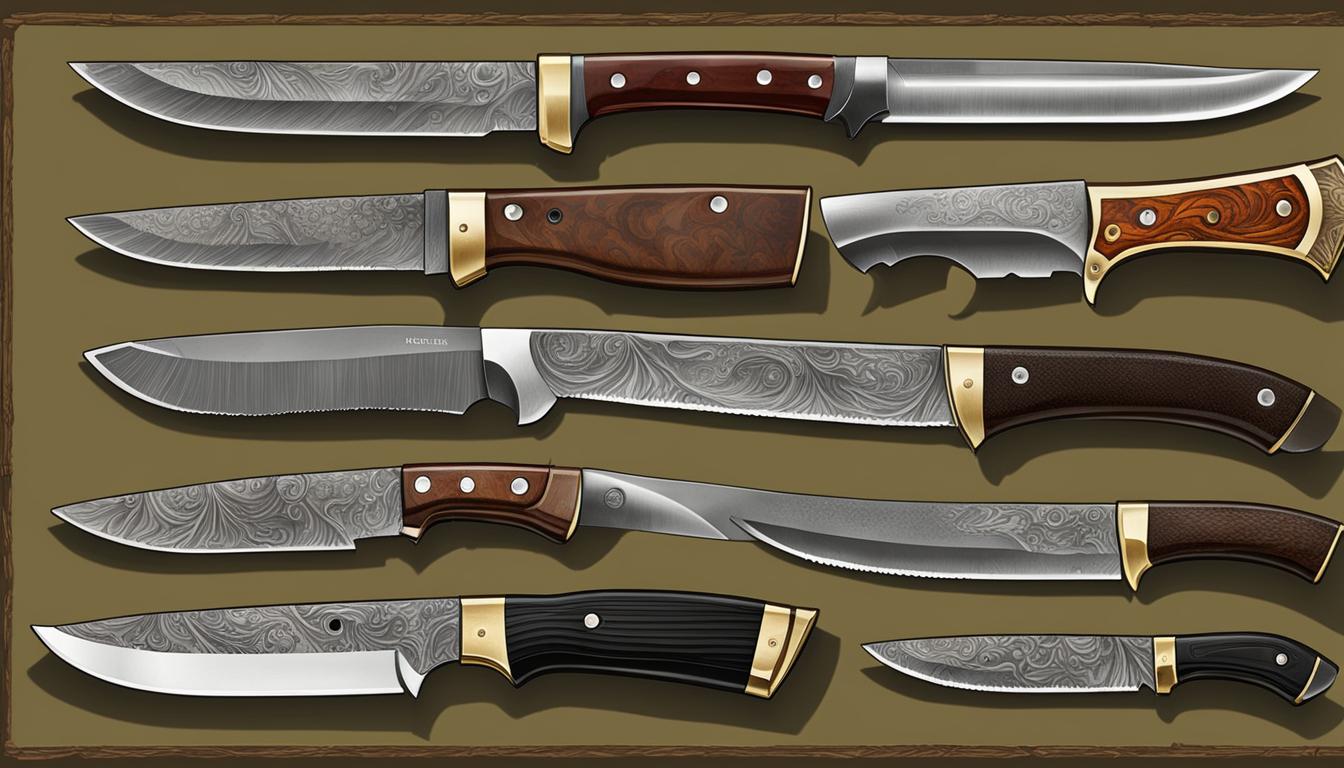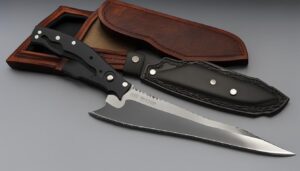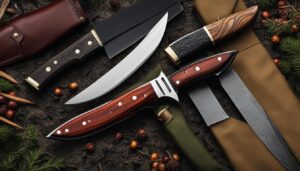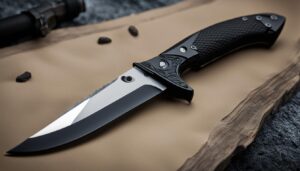As an outdoor enthusiast and hunter, I understand the importance of having the right tools for the job. When it comes to hunting, a reliable and high-quality hunting knife is an essential companion. But with so many variations and features to consider, how do you know which one is right for you?
In this article, I will take you on a journey through the distinctive features of hunting knives, unraveling the key differences that set them apart. From blade types and materials to blade size, handle materials, and tang types, we will explore each aspect to help you make an informed decision.
Key Takeaways:
- Understanding the different blade types in hunting knives
- Choosing the right blade material for your needs
- Considerations for blade size and thickness
- Exploring handle materials and their benefits
- Understanding the importance of tang types in hunting knives
Understanding Blade Types: The Foundation of a Hunting Knife
When it comes to hunting knives, the blade type plays a crucial role in determining its functionality and performance. Different blade types offer unique advantages for various tasks in the field. Understanding these blade types is essential for selecting the right hunting knife that suits your needs.
Drop Point Blade
The drop point blade is one of the most popular blade types for hunting knives. It features a strong and durable blade that slopes gradually from the handle to the tip, creating a point that is lowered and wider. This design provides excellent control and versatility, making it suitable for a wide range of tasks such as skinning, slicing, and general utility tasks.
Clip Point Blade
The clip point blade is another common blade type found in hunting knives. It is characterized by a concave cut-out near the tip, resulting in a sharper and more pointed tip compared to the drop point blade. This blade style offers enhanced precision for detailed work such as piercing and delicate cutting tasks.
Gut Hook Blade
The gut hook blade is specifically designed for field dressing game animals. It features a sharpened hook on the spine of the blade, near the tip. This hook allows for easier opening and cleaning of the animal’s body cavity without puncturing internal organs. The gut hook blade is a valuable tool for hunters who prefer to field dress their game in the field.
Each blade type has its own advantages and is suited for specific hunting tasks. Whether you need versatility, precision, or specialized functionality, understanding the different blade types will help you make an informed decision when choosing your hunting knife.
| Blade Type | Advantages | Common Uses |
|---|---|---|
| Drop Point Blade | Control, versatility | Skinning, slicing, general utility |
| Clip Point Blade | Precision, detailed work | Piercing, delicate cutting |
| Gut Hook Blade | Easier field dressing | Opening and cleaning game animals |
Decoding Blade Materials: Choosing the Right Material for Your Needs
When it comes to hunting knives, the blade material plays a crucial role in determining its performance and durability. Understanding the different types of blade materials available can help you make an informed decision based on your specific needs and preferences.
There are three common blade materials used in hunting knives: stainless steel, carbon steel, and high-carbon stainless steel. Each material has its own set of characteristics and advantages.
“The choice of blade material depends on factors like corrosion resistance, edge retention, and ease of maintenance.”
The Different Blade Materials Explained
Stainless Steel: Stainless steel blades are known for their excellent corrosion resistance. They are less prone to rust and are easy to maintain. However, stainless steel blades may be slightly harder to sharpen and may not hold their edge as well as other materials.
Carbon Steel: Carbon steel blades are highly regarded for their exceptional sharpness and edge retention. They are easier to sharpen and can maintain their edge for longer periods. However, carbon steel blades are more susceptible to rust and require proper care to prevent corrosion.
High-Carbon Stainless Steel: High-carbon stainless steel blades offer a balance between corrosion resistance and edge retention. They combine the best aspects of stainless steel and carbon steel, making them a popular choice among hunters. High-carbon stainless steel blades are durable, easy to maintain, and offer excellent cutting performance.
| Blade Material | Corrosion Resistance | Edge Retention | Maintenance |
|---|---|---|---|
| Stainless Steel | High | Moderate | Easy |
| Carbon Steel | Moderate | High | Moderate |
| High-Carbon Stainless Steel | Moderate to High | High | Easy |
Remember, when choosing a hunting knife, consider the specific needs of your outdoor activities and the environment in which you will be using it. Whether you prioritize corrosion resistance, sharpness, or ease of maintenance, understanding the differences in blade materials will help you find the perfect hunting knife that suits your requirements.
Finding the Perfect Fit: Understanding Blade Size and Thickness
When it comes to hunting knives, choosing the right blade size and thickness is essential for optimal performance in the field. The size and thickness of the blade can greatly impact the knife’s versatility, strength, and precision. Let’s explore how blade size and thickness play a crucial role in finding the perfect fit for your hunting needs.
Blade Size
The blade size of a hunting knife refers to the length of the blade. It is important to consider the intended use of the knife when determining the ideal blade size. A shorter blade, typically ranging from 3 to 4 inches, is ideal for delicate tasks such as field dressing and skinning small game. It allows for greater control and precision, making it easier to handle detailed work. On the other hand, a longer blade, ranging from 4 to 6 inches, is better suited for heavier tasks like field dressing larger game.
It’s worth noting that the blade size should also be in proportion to the size of your hand. A blade that is too long or too short may affect your ability to handle the knife comfortably and safely. Consider your hand size and grip preferences when selecting the blade size that feels most natural to you.
Blade Thickness
The thickness of the blade is another important factor to consider when choosing a hunting knife. Blade thickness directly affects the knife’s strength and durability. Thicker blades provide additional strength and are less likely to bend or break under heavy use. They are ideal for tasks that require brute force or heavy-duty cutting, such as chopping or batoning wood for a campfire.
On the other hand, thinner blades offer increased precision and are better suited for tasks that require intricate and detailed work. Thinner blades excel in tasks like filleting and skinning, as they are more maneuverable and allow for greater control.
It’s important to strike a balance between blade thickness and intended use. Consider the type of hunting you will be participating in and the tasks you expect to perform with the knife. This will help you determine the appropriate blade thickness for your specific needs.
In summary, understanding blade size and thickness is crucial when selecting a hunting knife. The blade size should be chosen based on the intended use and the size of your hand. Consider a shorter blade for delicate tasks and a longer blade for heavier tasks. Blade thickness should be determined by the type of hunting and tasks you expect to perform. Thicker blades offer strength and durability, while thinner blades provide precision and control. By finding the perfect fit in terms of blade size and thickness, you can ensure that your hunting knife meets your specific needs and enhances your overall hunting experience.
Gripping the Hunt: Exploring Handle Materials for Hunting Knives
When it comes to hunting knives, the handle material is just as important as the blade. The right handle can provide a comfortable and secure grip, ensuring precise control during your hunting expeditions. There are several handle material options available, each with its own unique characteristics and advantages.
Wood Handles
Wooden handles are a popular choice for hunting knives, offering a traditional and timeless aesthetic. They provide a warm and natural feel, allowing for a classic hunting experience. However, it’s important to note that wood handles require more maintenance compared to other materials. Regular oiling and cleaning are necessary to keep the wood in good condition and prevent it from drying out or warping.
Rubber/Polymer Handles
For those seeking a handle that offers excellent grip, especially in wet conditions, rubber or polymer handles are a great option. These materials provide a non-slip surface, ensuring a secure hold even when your hands are damp or sweaty. Rubber and polymer handles are also known for their durability and resistance to impact, making them ideal for rugged outdoor use.
G10/Micarta Handles
G10 and Micarta handles are engineered materials that offer a combination of strength, durability, and moisture resistance. G10 is a composite material made of fiberglass and epoxy resin, while Micarta is a layered material comprising linen or paper impregnated with resin. Both G10 and Micarta handles are lightweight yet rugged, providing a secure grip and withstanding harsh environmental conditions.
| Handle Material | Advantages |
|---|---|
| Wood | Traditional aesthetic Warm and natural feel |
| Rubber/Polymer | Excellent grip, even in wet conditions Durable and impact-resistant |
| G10/Micarta | Strong, lightweight, and durable Moisture-resistant |
When choosing a hunting knife, consider your personal preferences, the intended use, and the environmental conditions you expect to encounter. Remember that the handle material plays a crucial role in providing comfort, control, and reliability during your hunting adventures. Whether you prefer the classic charm of wood, the dependable grip of rubber/polymer, or the strength of G10/Micarta, there’s a handle material that’s perfect for you.
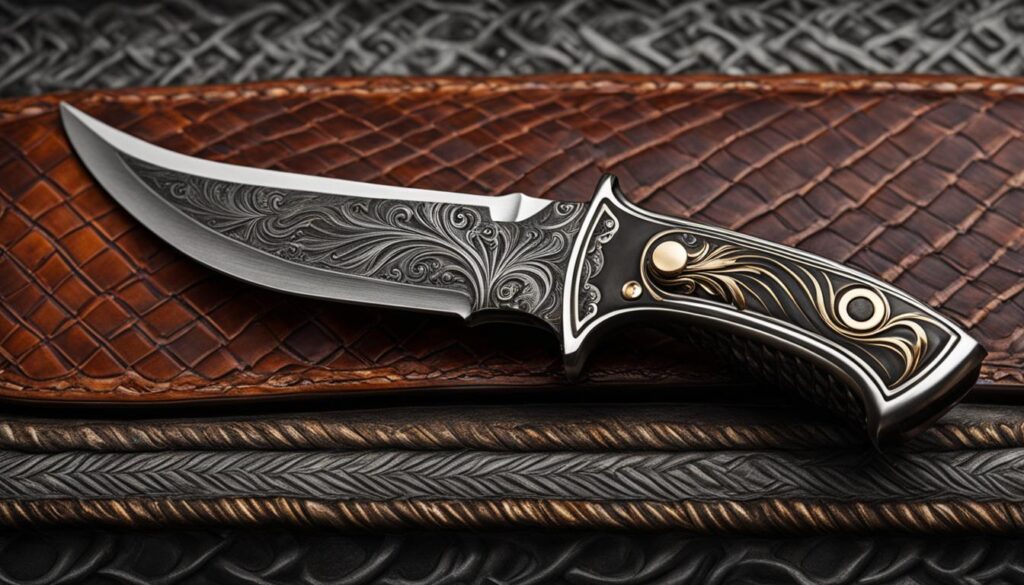
Reinforcement and Stability: Understanding Tang Types in Hunting Knives
When it comes to hunting knives, one important consideration is the tang type. The tang refers to the portion of the blade that extends into the handle, and it plays a crucial role in the overall strength and stability of the knife.
There are two common tang types found in hunting knives: full tang and partial tang. Understanding the differences between these options will help you make an informed decision when choosing a hunting knife that suits your needs.
Full Tang
A full tang knife has a blade that extends the entire length of the handle. This design provides maximum strength and durability, making it well-suited for heavy-duty tasks such as field dressing game animals or outdoor survival situations. The solid construction of a full tang knife ensures that the blade is less likely to break or separate from the handle, even when subjected to significant force or pressure.
Partial Tang
A partial tang knife, on the other hand, has a blade that extends only partially into the handle. This design makes the knife lighter and more compact, which can be advantageous for those who prefer a lightweight option or need a knife for occasional use. However, it’s important to note that partial tang knives may be less durable and not as well-suited for heavy-duty tasks.
Ultimately, the choice between a full tang and partial tang knife depends on your intended use and personal preferences. If you require a hunting knife that can withstand rigorous use and provide maximum stability, a full tang knife is the way to go. However, if you prioritize portability and occasional use, a partial tang knife may be a suitable option. Consider the demands of your hunting expeditions and choose a tang type that aligns with your specific needs.
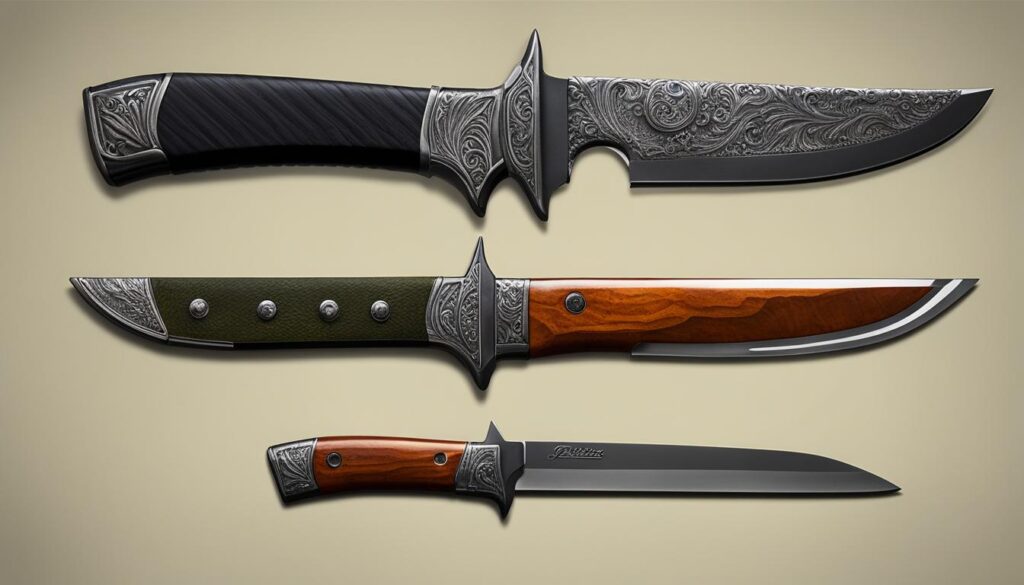

| Tang Type | Key Features | Best Use |
|---|---|---|
| Full Tang | Blade extends the entire length of the handle | Heavy-duty tasks, maximum strength and durability |
| Partial Tang | Blade extends only partially into the handle | Lightweight, compact, occasional use |
The Charm of Traditional Folding Knives: Exploring their Unique Features
Traditional folding knives have captivated knife enthusiasts for centuries with their rich history and exquisite craftsmanship. These unique knives showcase distinctive features that set them apart from other knife styles, making them highly sought after by collectors and outdoor enthusiasts alike.
One of the defining characteristics of traditional folding knives is their intricate design and attention to detail. These knives often feature beautiful engravings and decorative etchings on both the blade and handle, showcasing the skill and artistry of the knife maker. Each folding knife style, such as the slip joint, lockback, barlow, trapper, stockman, and pen, has its own unique aesthetics, allowing knife enthusiasts to find a style that truly resonates with them.
Aside from their stunning appearance, traditional folding knives offer practical features that make them versatile tools in various situations. These knives are compact and lightweight, making them easy to carry and store. The folding mechanism allows the blade to be safely tucked away within the handle, reducing the risk of accidental cuts and providing convenience for everyday carry.
| Folding Knife Style | Unique Features |
|---|---|
| Slip Joint | Non-locking blade, requires manual pressure to keep the blade open |
| Lockback | Locking mechanism that locks the blade in the open position |
| Barlow | Distinctive elongated handle, usually with two blades |
| Trapper | Two blades, usually a clip and spey blade, perfect for a variety of tasks |
| Stockman | Triple-bladed knife with clip, spey, and sheepsfoot blades |
| Pen | Slim design, often used as a pocket penknife |
Whether you appreciate the historical significance, the intricate design, or the practicality of a folding knife, these traditional knives offer a charm and elegance that is hard to resist. Embrace the legacy of these timeless tools and experience the unique features they bring to the world of knives.
Unique Characteristics of Traditional Folding Knives
- Elegant engravings and decorative etchings
- Compact and lightweight design
- Versatile folding mechanism for safe and convenient carry
- Multiple styles with unique features like non-locking blades, locking mechanisms, and various blade configurations
Immerse yourself in the world of traditional folding knives and discover the allure of these exceptional blades that have stood the test of time.
Conclusion
As I conclude this article, it is evident that hunting knives come in various variations and feature unique characteristics. The key to choosing the right hunting knife lies in understanding the differences among blade types, materials, sizes, handle materials, tang types, and overall design.
When deciding on a hunting knife, consider the intended use, durability, and functionality. Whether you prefer a traditional folding knife with intricate engravings or a modern hunting knife, it is crucial to find one that suits your specific needs and preferences.
Remember to prioritize factors such as blade type for the desired tasks, blade material for rust resistance and sharpness, blade size and thickness for the nature of your hunting activities, handle material for grip and maintenance, and tang type for strength and stability.
By understanding the variations and features of hunting knives, you can confidently choose the perfect tool for your hunting adventures. Happy hunting!
FAQ
What are the key differences in hunting knife features?
Hunting knives can vary in blade type, blade material, blade size, handle material, and tang type, among other factors.
What are the different blade types in hunting knives?
Hunting knives can have drop point, clip point, and gut hook blade types, each offering different functionalities.
What are the options for blade materials in hunting knives?
Hunting knife blades can be made from stainless steel, carbon steel, or high-carbon stainless steel, each with its own advantages and considerations.
How do I choose the right blade size for a hunting knife?
Consider the intended tasks – a shorter blade is ideal for delicate work, while a longer blade is better for heavier tasks like field dressing.
What are the different handle materials available for hunting knives?
Hunting knife handles can be made from wood, rubber/polymer, or G10/Micarta, each offering different levels of grip, durability, and maintenance requirements.
What is the difference between full tang and partial tang hunting knives?
Full tang knives have a tang that extends the entire length of the handle, providing maximum strength and stability. Partial tang knives are lighter but not as durable.
What are the unique features of traditional folding knives?
Traditional folding knives have a long history and come in various styles like slip joint, lockback, barlow, trapper, stockman, and pen, often featuring intricate engravings and decorative etchings.
How do I choose the right hunting knife for my needs?
Consider the specific tasks you’ll be performing, durability, and functionality when selecting a hunting knife to ensure it suits your needs and preferences.
